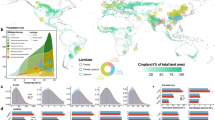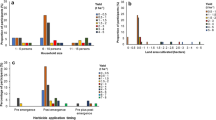Abstract
Food production in the densely populated Rwandan highlands is impeded by soil erosion and loss in fertility. Alley cropping leguminous shrubs with food crops on contours is purported to minimize the problem and to provide wood and forage. This study reports the effect of Sesbania prunings plus moderate levels of N and P on bean (Phaseolus sp) and maize (Zea mays) yields in alley cropping. Experimental design was a randomized complete block with split-split plots. Main plots were alley width: 2, 4, 6 and 8 m. Phosphorus (P) at 0, 30 and 60 kg P2O5/ha occupied the subplot and nitrogen (N) at 0, 30 and 60 kg/ha were assigned at the sub-sub plot level. No P was applied to maize during the second cropping season. Crop yield in kg/ha included the land space taken by hedgerows. Bean yield in 6 m alleys (1100 kg/ha) was about twice that in 2 m alleys (500 kg/ha). Bean responded to N and P. Optimum alley width and N for bean yield were 6 m and 30 kg/ha, respectively. Cuttings from alley hedgerows provided stakes for climbing beans. Maize responded to N but not to residual P. The highest maize yield came from 8 m alleys with 40 kg/ha, but yields from 8 and 6 m alleys with the same N treatment were not significantly different. Maize plants in middle rows were significantly taller than plants in rows adjacent to hedgerows. Maize rust development showed significant alley width and row position effect. There were significantly fewer uredinia in the Sebania alleys relative to the control plots without shrub hedgerows. Rust development on maize in middle rows was significantly greater than development in border rows.
Similar content being viewed by others
References
Balasubramanian V and Sekayange L (1988) Alley cropping in semi-arid highlands of Rwanda: Evaluation of five shrubs for the system. Projet FSR á l'ISAR-Karama, Rwanda. Unpublished report, 23 pp
Garrison GA (1971) Carbohydrate reserves and response to use. In Wildland shrubs — their biology and utilization. Proceedings of an international symposium, Utah State University. Logan, Utah.pp 271–278
International Council for Research in Agroforestry (ICRAF) (1986) Field station status report. Machakos, Kenya pp 21–23
ICRISAT (International Crops Research Institute for the Semi-Arid Tropics) (1987) Annual Report 1986. Patancheru AP 502324, India; ICRISAT. pp 306
IITA (1984) International Institute of Tropical Agriculture. Research Highlights for 1983. Ibadan, Nigeria. pp 28–29
IITA (1985) Research Highlights (1984) International Institute of Tropical Agriculture, Ibadan, Nigeria, pp 94
Kenya Woodfuel Development Programme (KWDP) (1985) How to start a tree nursery. The Beijer Institute, Nairobi, Kenya, 16 pp
Kenya Renewable Energy Development Project (KREDP) (1985) Agroforestry information bulletin. No 1. Ministry of Energy and Regional Development, Nairobi, Kenya. 31 pp
Lundgren B and Nair PKR (1985) Agroforestry and soil conservation. In: Soil erosion and conservation. Ankeney. Soil Conservation Society of America, pp 703–717
Nduwayezu B (1988) Approache á l'agroforesteri de haute altitude dans le projet R.R.A.M. Ministére de l'Agriculture, de l'Elevage et des Forêts. Republique Rwandais, Kigali, 13 pp
Neumann I and Pietrowicz P (1983) Vorlaufige Ergebnisse agrarkologischer und pedologischer Forschug de ‘Projet Agro-Pastoral de Nyabisindu’. In: PANPN, Jahresbericht 1982, Nyabisindu, Rwanda
Prinz D (1986) Increasing the productivity of small holder farming systems by introduction of planted fallows. Plant Research and Development, vol 24 pp 31–56
Rotar PP and Evans DO (1983) Sesbania as an LDC agroforestry resource. Departement of Agronomy and Soil Science. College of Tropical Agriculture and Human Resources. University of Hawaii at Manoa, 197 pp
Sanchez PA (1987) Trees as soil improvers in the mid tropics. In: Tropsoils technical report 1985–1986. North Carolina State University, Raleigh, NC, pp 22
Sanchez PA and Benites JR (1987) Low-unput cropping for acid soils of the humid tropics. Science Vol 238, pp 1521–1527
Shaner G and Finney RE (1977) The effect of nitrogen fertilizer on the expression of slow mildewing resistance in Knox wheat. Phytopathology 67: 1051–1056
Steiner KG (1987) On Farm Experimentation Handbook for Rural Development Projects. Guidelines for the development of ecological and socio-economic sound extension messages for small farmers. GTZ Publication, Eschborn, West Germany, pp 187
Westwood S (1986) Agroforestry component of the CARE Gituza Project. (Mimeog.) CARE Rwanda, 18 pp
Wilson GF and Kang BT (1981) Developing stable and productive biological cropping systems for the humid tropics. In: Biological Husbandry. A scientific approach to organic farming. (B Stonehouse ed). Butterworth, London. pp 193–203
Wilson GF, Kang BT and Mulongoy K (1986) Alley cropping trees as sources of green manure and mulch in the tropics. Biological Agriculture and Horticulture, vol. 3, pp 251–267
Yamoah C (1988) The potential of alley cropping for hillside farming in Rwanda. Appropriate Technology Vol 15 No 1, pp 28–30
Young A (1984) Evaluation of agroforestry potential in sloping areas. A working paper No 27. ICRAF, Nairobi, Kenya. 36 pp
Author information
Authors and Affiliations
Rights and permissions
About this article
Cite this article
Yamoah, C.F., Burleigh, J.R. Alley cropping Sesbania sesban (L) Merill with food crops in the highland region of Rwanda. Agroforest Syst 10, 169–181 (1990). https://doi.org/10.1007/BF00115365
Issue Date:
DOI: https://doi.org/10.1007/BF00115365




